We can locate the first settlement of Florence along the Arno River, where the Etruscans had built a ford at the closest point between the river banks. This was probably a wooden footbridge, which rested on stone piers. The ford stood not far from today’s Ponte Vecchio and connected the city of Vipsul, the ancient Fiesole with its more salubrious hills than the plain, to the rest of Etruria. The Etruscan toponym of Florence is not known but at that time probably was already in use the Latin name of Florentia and, among the echoes of history, such a good omen found fulfillment: may you be prosperous forever, Florence!
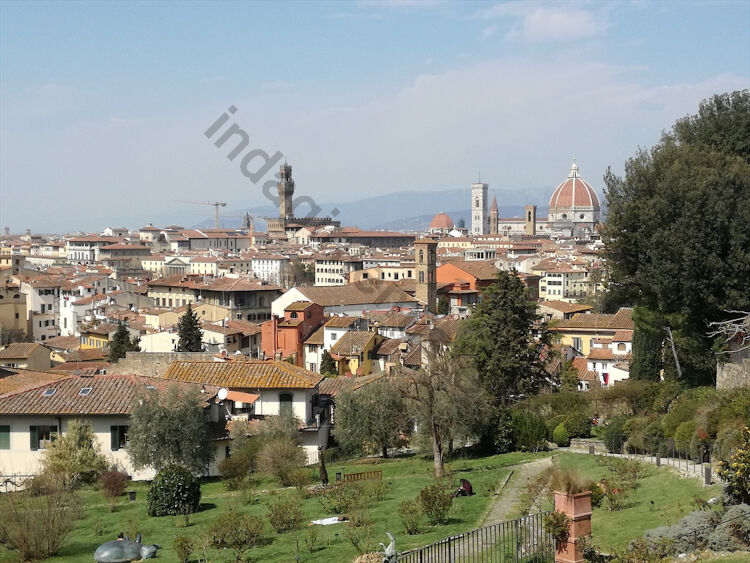
The Roman origins of Florence
When the Romans began their expansion towards the Po Valley, they made the Via Cassia Nova pass over the same place of the ancient ford. It was a sign of the increased importance of the settlement, and it was in Florentia that the Romans decided to build a colony to control the plain. They first had to drain the area, which was rather marshy at the time, perhaps by Julius Caesar’s will. Thus a settlement was built, according to a tradition in 59 B.C., as remuneration for army veterans. The Liber Coloniarum informs us of a lex Iulia agris limitandis metiundis, commissioned by Caesar, by which he expressed his intention to establish by the Arno River a new village1. It grew rapidly and, in honor of its military origins, the Romans dedicated it to the god Mars.
Hence, the colony was built up following the standard orientation along the cardinal axes: the decumanus maximus ran from east to west, the cardo maximus from north to south. Near the area of the current Piazza della Repubblica the two main axes intersected where there was the city forum. Archaeological excavations carried out in the middle of the 20th century have traced the primitive boundary wall made of bricks. It has numerous fortified towers, which enclosed the quadrangular core of the city and opened to four entrance gates. From Hadrian’s age onward, the buildings typical of Roman city life were constructed: the baths, aqueduct, theater, and amphitheater.
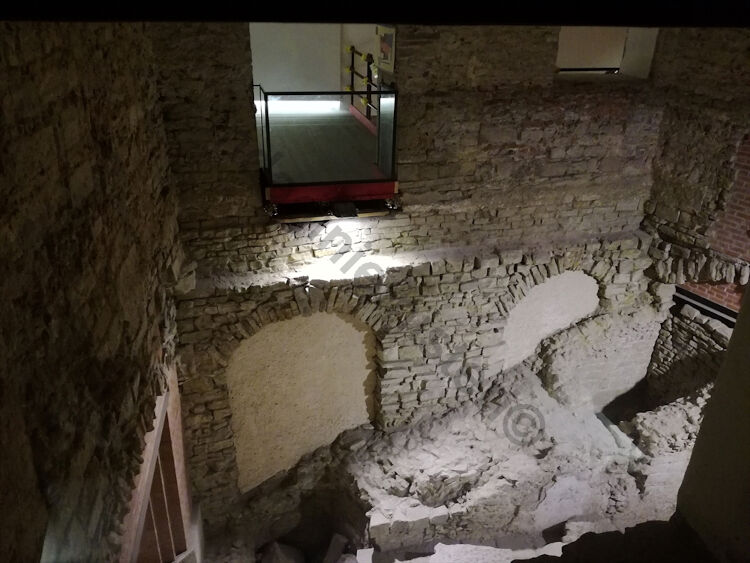
Underground Florence
Although Florentia was a crucial outpost for the Romans, visible evidence of its past is rather scarce today. The rapid Medieval expansion of the city led to the almost total loss of ancient buildings, though the original urban planning layout was preserved.
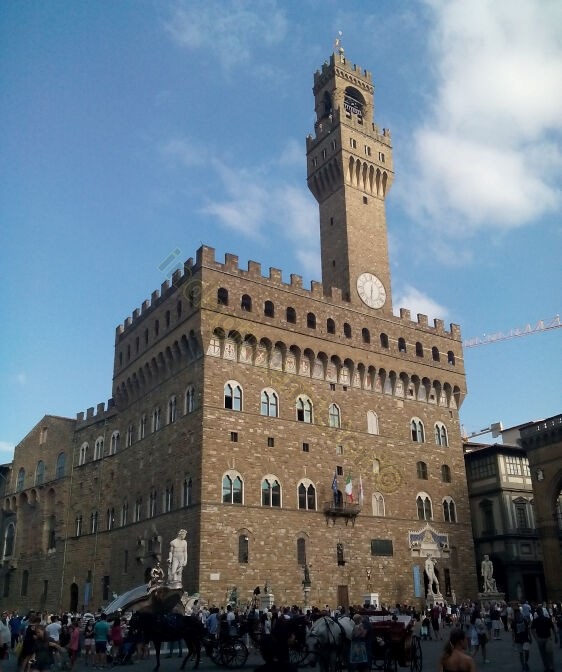
The few remaining architectural findings, on which excavation and rediscovery work is slowly ongoing, are known as underground Florence, since they are mainly located below the ground level. These include the remains of the ancient theater (1st-2nd century AD), found under Piazza della Signoria at a depth of about four meters.
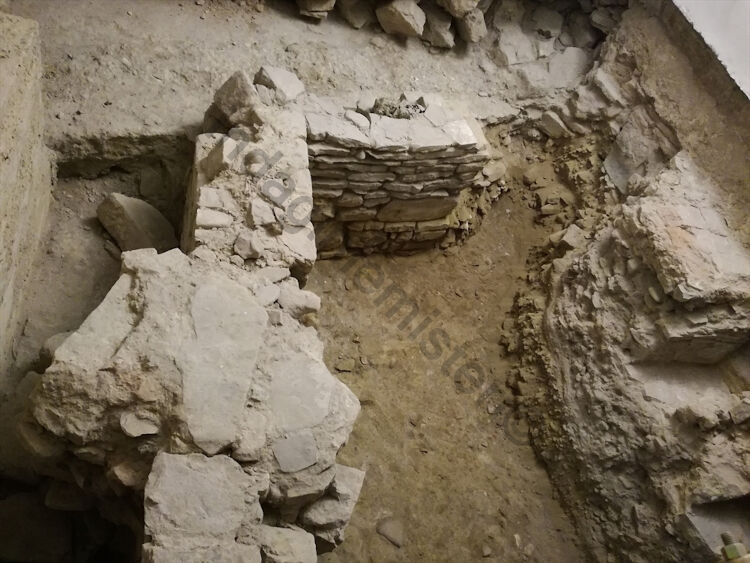
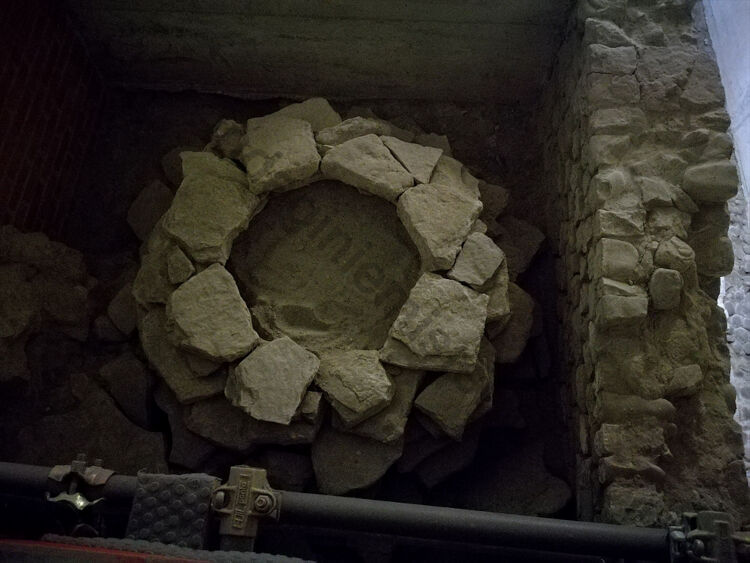

The sacred axis: the church complex of Santa Reparata and San Giovanni
St. Ambrose, bishop of Milan, visited Florence in 393 in order to establish and consecrate the Basilica of San Lorenzo. This is the event that, more than any other, attests the beginning of Florence’s early Christian era. The city already had the cult of its martyrs, such as Miniatus, who was beheaded during the persecution of Decius (250). However, the arrival of Ambrose marked the beginning of a great architectural season.

Archaeology attests to the presence of a cult center, starting in the early Christian age, in the area where Santa Maria del Fiore stands today. It was developed over the centuries along the line of a sacred axis, close to the primitive Roman walls in the north. During the 13th century the axis included the cathedral of Santa Reparata, the Baptistery of San Giovanni, the bishop’s palace and the dispensary of San Giovanni Evangelista. The spatial arrangement of the area was certainly less monumental than it is today. So while the Baptistery has over time survived, only a few traces remain of Santa Reparata; the ancient church was demolished in 1296 to construct Santa Maria del Fiore.

The Cathedral of Santa Reparata
Excavations led by Guido Morozzi since 1965, and completed by Franklin Toker2, have tracked down the existence of Santa Reparata under Santa Maria del Fiore. The several architectural remains allowed to ascertain its early Christian origins and the evolution of the building over the centuries through different construction phases.
The church is documented since the 5th century, but the dating is indeed debated, and some historians point out to the 6th century3. Tradition, not corroborated by faultless historiographical sources, traces its foundation to the years following the conflict with the Ostrogoths and the Heruli of Radagaiso. In fact, they had invaded the plain of Florentia in late 4054. During the Battle of Fiesole, the barbarians were pushed back by Stilicho’s Roman armies. Thus, it is possible that this event sparked a period of renewal for the city. A new cathedral was built as thanksgiving for the narrow escape from danger, although the reason for the dedication to St. Reparata is still controversial.

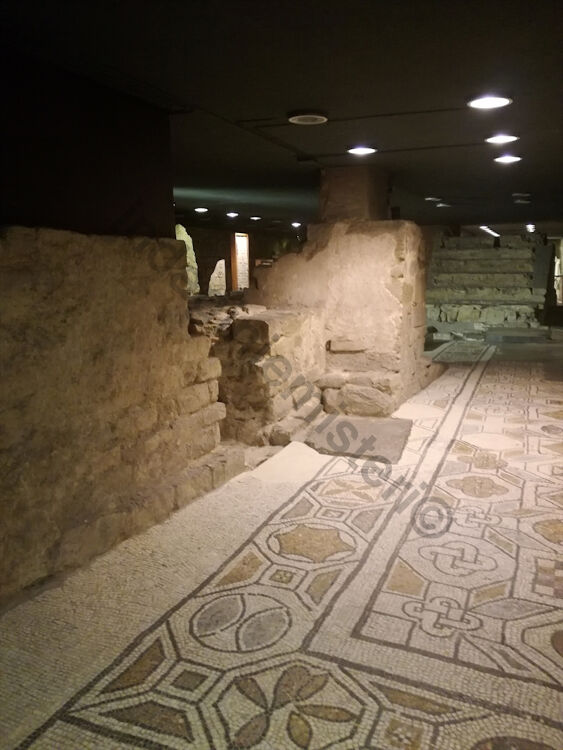
The saint, in fact, is remembered in the liturgical calendar on the eighth of October, but the battle against Radagaiso took place in August. It is most likely that the original dedication of the building was for the Savior, as was common in early Christian times. Only in the 10th century the Cathedral’s title changed to Santa Reparata5, like the nearby Lucca which held the relics of the martyr of Caesarea.
First church
The dating of the oldest archaeological remains, in the crypt of Santa Maria del Fiore, provides a plausible framework for the origins of Santa Reparata. The floor of the church is layered over some earlier Roman buildings, as evidenced by the discovery of coins, including those of the Emperor Honorius (395-423). In addition, a glass chalice, dating no later than the 7th century, was found in a reused tomb. Therefore, the building is most likely to date back to the 5th or 6th century6.
Excavations have shown that the early Christian cathedral of Santa Reparata had a nave and two aisles with fourteen pairs of columns, a semicircular apse, and a large mosaic floor. The building had an overall length of about 60 meters. This is, however, an estimation still to be verified since the first bays of Santa Reparata have not yet been excavated. They are located under the churchyard and the access staircase to Santa Maria del Fiore. Some mosaic portions are still well preserved and rich early Christian (the peacock, the chalice) and Roman-imperial (Solomon’s knot) symbolism can be distinguished.
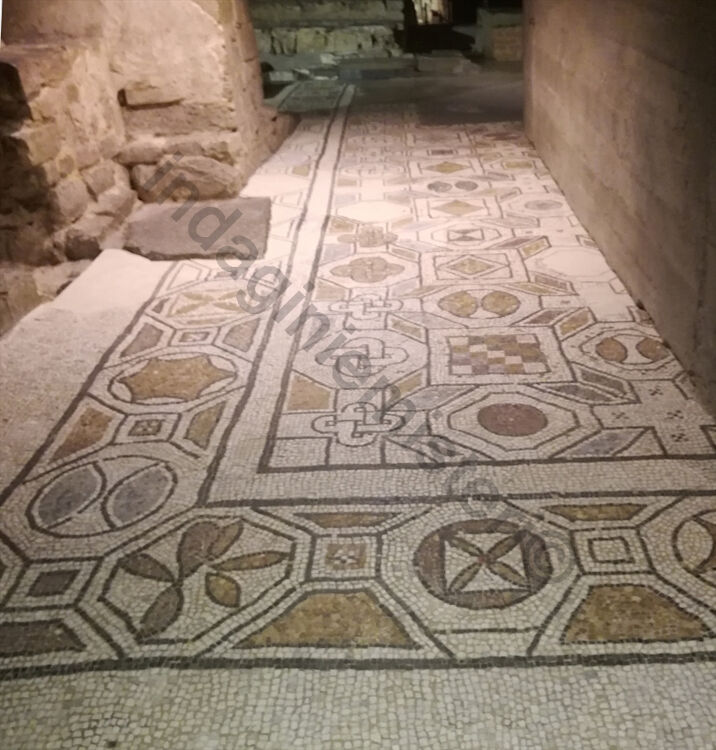
The next construction stages
A first reconstruction of Santa Reparata took place during the Carolingian-Ottoman times. Excavations have revealed a general rearrangement of spaces, while maintaining the pre-existing perimeter definition. In particular, the columns were replaced with seven pairs of pillars and the crypt was added. Here the remains of St. Zanobi were moved from the nearby Basilica of San Lorenzo, perhaps during the tenure of Bishop Andrew (869-898). Further, the two bell towers were added in the 10th century, and other work was begun in preparation for the Council of Florence in 1055. To this period dates the portico, leaning against the facade, the foundations of which were discovered in the space in front of the churchyard of Santa Maria del Fiore.
The tomb of Filippo Brunelleschi was found inside Santa Reparata. Tradition claims that Giotto, Arnolfo di Cambio and Nicola Pisano are also buried here, although scholars have not yet found their tombs.
The Baptistery of San Giovanni
The origins of the Baptistery of San Giovanni, now just a few meters from the facade of Santa Maria del Fiore, are a controversial topic among contemporary archaeologists.
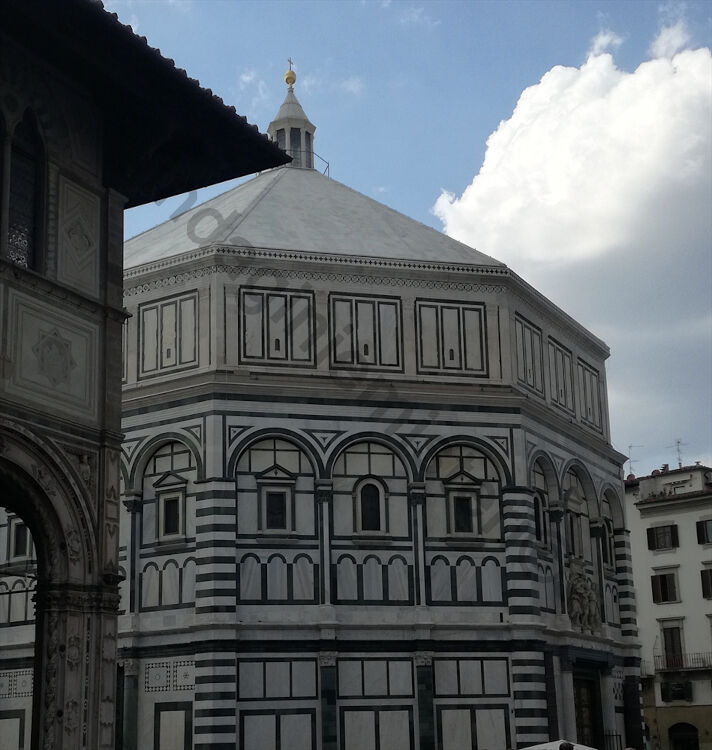
Until 1500, especially on the basis of what Giovanni Villani (1280-1348) wrote in his Nuova Cronica, it was believed that the Baptistery was anciently a temple of Mars, later transformed into a building of Christian worship. This thesis, according to the Florentine chronicler, was supported by the presence of a statuette of the god on horseback coming from the top of the temple, on which it would have stood. Supernatural powers were attributed to the sculpture, made of marble and later placed near Ponte Vecchio, and even before Villani, it was Dante who had made mention of it in the Comedy:
But it behoved the mutilated stone
Dante Alighieri, Divine Comedy, Chapter 16th of the Paradiso
Which guards the bridge, that Florence should provide
A victim in her latest hour of peace.
Today scholars critically examine this historical view. The statuette, presumed to be of Mars, was lost during the Florence flood of 1333. In addition, excavations carried out in the area of the Baptistery did not reveal the foundations of a temple, but of pre-existing first-century Roman dwellings.
A historiographical misunderstanding
Stratigraphic reconstructions, moreover, did not show the presence of early Christian remains, as most believed. Among the hypotheses had been that the Baptistery would have built after the expulsion of the Ostrogoths in 405 and would have consecrated to Mars, as a celebration of a military victory. This historical misunderstanding stems from the fact that, in canonical documents from the 9th century onward, Florentines refer to the Cathedral indifferently as San Giovanni or Santa Reparata, indicating a double dedication, and not of two different buildings7!
Therefore, when the Notitia iudicati of 897 reveals that the imperial ambassador Adalbert held jurisdictional functions before the “basilica of St. John the Baptist”, “in atrio contra ecclesia sancti Iohanni Battiste, domus“, it is to be considered as referring to the Cathedral itself. So, for the consecration on November 6, 1059, by Pope Nicholas II too.
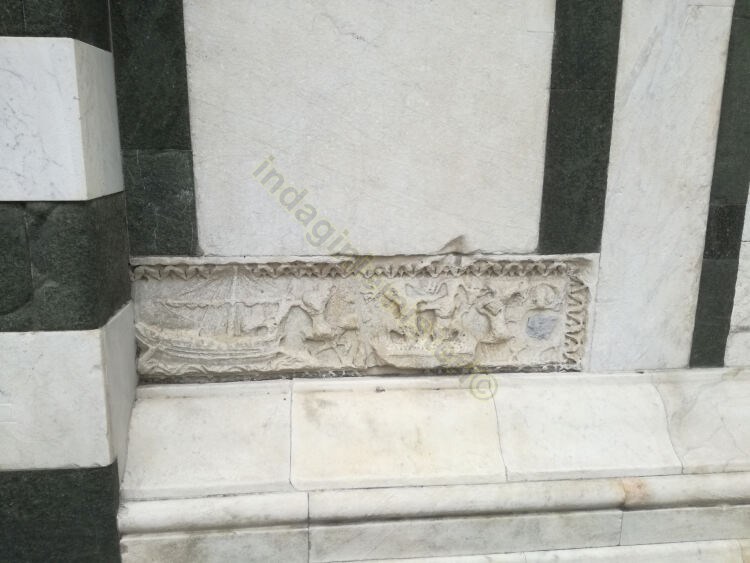
The Medieval Origin
Based on the above, the Florentine Baptistery is of Medieval origin, a consideration that explains its octagonal shape. It was built, therefore, already with a sacramental function since in the Christian tradition the eighth day identifies eternal life, the time of man being reborn through baptism. Indeed, the Books of Calimala attest that in 1128 the baptismal font was moved from Santa Reparata to San Giovanni. This is a fundamental clue that allows us to testify to the presence of the Baptistery of Florence at that date, probably around the time of its construction.
Hence, the building was covered with white Carrara marble and serpentine from Prato; the affixing of the lantern, commissioned by the Calimala Art in 1150, marked the conclusion of the work.
The Baptistery and the first beginnings of the Renaissance
The Baptistery is entered through three bronze doors, carved at different times between 1329 and 1452. They mark a boundary, a limen in a spatial sense, but also a moment of historical and artistic passage. Andrea Pisano’s South doors, with stories of the Baptist (1329-1336), was created in the context of a solid Gothic tradition. Conversely, the competition for the North doors (1401) revealed the early beginnings of the Renaissance, which changed the way of thinking about art a few decades later.
Different artists participated to the competition, including Lorenzo Ghiberti and Filippo Brunelleschi. A bronze quatrefoil panel, with the theme of the Sacrifice of Isaac, determined the winner. Ghiberti’s work was conceived in stylistic continuity with Pisano’s existing work, introducing International Gothic stylistic features; Brunelleschi, instead, proposed a new style, with references to classical art. His panel was characterized by dynamism and an expressive force never seen before then.
The competition, according to some historians, had both winners Lorenzo Ghiberti and Brunelleschi, but the latter refused to work with his colleague. Ghiberti made the North doors between 1403 and 1424, with the Stories of the New Testament; the following year he began working on the East doors of the Baptistery, known as the Gates of Paradise. Florence was not yet ready to embrace the Renaissance, but its seeds were already sown.
Samuele Corrente Naso
Map of places
Notes
- E. J. Shepherd, L’impianto produttivo del Vingone e la costruzione di Florentia, Rassegna di Archeologia 22B/2006. ↩︎
- G. Morozzi, F. Toker, J. Herrmann, Santa Reparata. L’antica cattedrale fiorentina. I risultati dello scavo condotto dal 1965 al 1974, Firenze 1974. ↩︎
- Herrmann, Morozzi e Farioli, Verdon propendono per il V secolo; Toker e Lopes Pegna per il VI. R. Chellini, La basilica di Santa Reparata a Firenze: dati acquisiti e problemi irrisolti. In T. Verdon, Firenze prima di Arnolfo, retroterra di grandezza, Atti del ciclo di conferenze, Firenze, 14 gennaio 2014-24 marzo 2015, Mandragora. ↩︎
- P. J. Heather, La caduta dell’impero romano: una nuova storia, Garzanti, 2006. ↩︎
- G. Tigler, Il Battistero e il Pantheon. In T. Verdon, Firenze prima di Arnolfo, retroterra di grandezza, Atti del ciclo di conferenze, Firenze, 14 gennaio 2014-24 marzo 2015, Mandragora. ↩︎
- Alberto Busignani e Raffaello Bencini, Le chiese di Firenze. 4. Quartiere di S. Giovanni, Le Lettere, Firenze 1988. ↩︎
- Ibidem note 5. ↩︎

